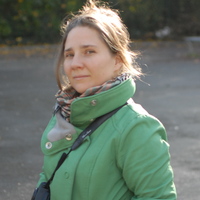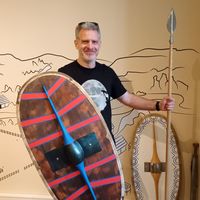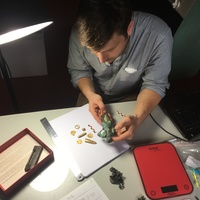Thesis Chapters by Ilona Bede
SOUTENANCE DE THESE / PhD DEFENCE 26/02 13h / 1PM , 2021
Books by Ilona Bede

Depuis trois décennies, le « barbare » a fait l’objet d’un intérêt accru. L’étude des civilisatio... more Depuis trois décennies, le « barbare » a fait l’objet d’un intérêt accru. L’étude des civilisations se focalisait jusqu’ici sur les espaces plus documentés par les sources écrites, mais une attention nouvelle est désormais accordée aux mondes jugés extérieurs, aux zones de contact, aux pratiques d’échanges et aux formes de la représentation mutuelle. Le barbare apparaît aujourd’hui moins comme l’ennemi irréductible du « civilisé » que comme un autre, que l’on doit construire par des dispositifs multiples et qui s’avère nécessaire pour se définir soi-même.
Deux cents spécialistes questionnent ici la création et l’exploitation de cette altérité à travers des exemples précis pris dans l’histoire mondiale et dans tous les domaines : philosophie, linguistique, sources textuelles, archéologie, histoire de l’art, lieux de mémoire, personnages historiques, droit, culture matérielle, ethnographie, sociologie, historiographie, muséographie, représentations médiatiques…
Tout autant introduction historique que dictionnaire exhaustif, cet ouvrage explore, depuis l’Antiquité jusqu’à nos jours, trois mille ans d’histoire de la barbarie.
Papers by Ilona Bede
Cahiers LandArc, 2021
At the end of the 19th century, a burial containing various objects was discovered in Aspres-lès-... more At the end of the 19th century, a burial containing various objects was discovered in Aspres-lès-Corps (Hautes-Alpes). These were quickly identified by Joseph Roman, a renowned local historian, as 10th century remains. After a century of oblivion, Mechthild Schulze-Dörrlamm recognised the grave of a Hungarian warrior. Since 2013, the joint attention of various actors has made it possible to recover some part of the furniture in the Musée museum départemental des Hautes-Alpes in Gap. Consisting of pieces of weaponry, ornaments and pierced coins, it is not the objects taken independently but the ensemble found in a well-identified context that allows the attribution of the remains. This rediscovery reopens the file on the presence of Hungarian troops west of the Alps in the 10th century, well known from written sources but little documented by archaeology.
JOURNOT Florence, [dir.] : Pour une archéologie indisciplinée, Réflexions croisées autour de Joëlle Burnouf, Editions Mergoil, Drémil-Lafage, 2018, p. 315-319 (Collection « Europe médiévale », 12), 2018
LORANS Elisabeth [dir.] : Le cheval au Moyen Âge, Actes du Xe Congrès de la Société d’Archéologie Médiévale, Arles : 3-5 Mai 2012, Presses Universitaires François Rabelais, Tours, 2017, p. 273-296 (+ pl. X-XII ; Annexe en ligne). (Collection « Perspectives historiques »)., 2017
DUMÉZIL Bruno (coord.), BAYARD Adrien, JOYE Sylvie, LEROUGE-COHEN Charlotte, MÉRY Liza : Dictionnaire des Barbares, Presses Universitaires de France, 2016
TRÉMEAUD Caroline, VALLETTE Thibault, BRANCIER Jeanne [dir.] : Des vestiges aux sociétés. Regards croisés sur le passage des données archéologiques à la société sous-jacente, Actes de la VIe Journée Doctorale d’Archéologie, 2015
Paris : 25 mai 2011, Presses Universitaires de la Sorbonne, Paris, p.129-153 (Archéo.Doct, VII)
In: BEDE I., DETANTE M. - Rencontre autour de l'animal en contexte funéraire : actes de la 4e Rencontre du Gaaf, Saint-Germain-en-Laye, 2014, p. 11-14
In: BEDE I., DETANTE M. - Rencontre autour de l'animal en contexte funéraire : actes de la 4e Rencontre du Gaaf, Saint-Germain-en-Laye, 2014, p. 211-225
SÖTÉT IDŐK REJTÉLYEI. 6–11. századi régészeti emlékek a Kárpát-medencében és környékén. TEMPORA OBSCURA 3, 2012
Horse in the Late Avarian society of the Carpathian Basin
The very beginning of Europe? Cultural and Social Dimensions of Early-Medieval Migration and Colonisation (5th-8th century)., Oct 2012
Talks by Ilona Bede

In the last decade, several studies has been focused on Hungarian military incursions in Western ... more In the last decade, several studies has been focused on Hungarian military incursions in Western Europe and in particular in south-eastern France.
The study of all Latin sources with mentions of Hungarian in a PhD thesis proposed a revision of the chronology and routes north and south of the Alps and a critical analysis of the apprehension and treatment of this historical episode. The results show that the Hungarian incursions had a significant impact and allow us to point out several places where these military campaigns may have leave some remains (objects, destruction, etc.).
At the same time a material ensemble of the most western remains of the 10th c. Hungarians discovered in a known context has been recovered in the Museum of Gap (Hautes-Alpes). A few years ago, a part of the material – missing since the mid-20th c. – has been rediscovered in the departmental museum of Gap: coins, arrow- and spearheads, knife. A possible location of the finds has been suggested in the village of Aspres-lès-Corps, which is known as a military strategic point on a secondary roman road connecting Gap/VAPINCUM and Grenoble/GRATIANOPOLIS.
This presentation proposes a “state of art” on the topic but aims to catch the attention to this type of remains and the new questions it raises. Our group of research intend to follow the routes and impact of Hungarian military campaigns, collecting (undefined?) material in regional collections, exploring potential new archaeological sites and contribute to archaeology and history of the 10th century regional context.

„Hadak útján” A népvándorláskor fiatal kutatóinak XXIX. Konferenciája. Budapest, 2019. November 15–16. Absztraktkötet (29th Conference of Young Scholars on the Migration Period. November 15-16, 2019, Budapest. Book of Abstract), 2019
A temetkezési rítust elemezve, a ló eredeti helyzetét és a sírba elhelyezését próbálok rekonstruá... more A temetkezési rítust elemezve, a ló eredeti helyzetét és a sírba elhelyezését próbálok rekonstruálni. Biológiai adatok és régészetre vonatkozó tafonómiai szabályok alapján a tetem lebomlás folyamatot és "térbeli kényszereit" vizsgálom. Eredményeim a ló eredeti pozíció és a sír építmény rekonstruálásra engednek, némi alkalommal, az ember tetemmel térbeli kapcsolat elemzésére is segítenek. Végül pedig néhány gondolatot teszem fel a ló megölés és sírba helyezéséről kapcsán.
Through the analysis of the funerary remains, I try to reconstruct the horse's initial position and the gestures of its placement in the grave. Based on biological data and archaeological rules, I examine the decomposition process of the corpse and the spatial constraints it faces. The results allow me to restore the initial position of the horse and the structure of the tomb, to analyse its relationship with human burial and finally to put forward some ideas about the killing and burying mode of equines in the central European Avar period.
Grâce à l'analyse des vestiges funéraire, je tente de reconstituer la position initiale du cheval et les gestes de sa mise en place dans la tombe. À partir des données biologiques et des règles de l'archéologie, j'examine le processus de décomposition du cadavre et les contraintes spatiales auxquelles il est confronté. Les résultats me permettent de restituer la position initiale du cheval et de la structure de la tombe, d'analyser ses relations avec l'inhumation humaine et d'émettre enfin quelques idées à propos de la mise à mort et de la mise en terre des équidés inhumés à la période avare.

Inhumation of horses is very well known for the Avar period (early Middle Age in Central Europe).... more Inhumation of horses is very well known for the Avar period (early Middle Age in Central Europe). This burial rite is always connected to the human funerary practices, as horses are buried in the same grave or the same cemetery as humans. Generally it is considered as a sign of nomadic tradition and as a status or wealth symbol of the deceased. We assume that the animal played a specific role within the rite: killing a living harnessed horse is different than burying a weapon or a piece of meat.
In a majority of horse burials of the Avar period, complete horses are found and we have shown their role as an accompanying death, sometimes as a substitute to the human dead. This contribution will discuss the case of partial horse burials, which constitute a minority but still a large part of horses’ inhumations. The fact that the animals are only partially buried (skull and extremities are only found in the grave) could lead to the conclusion of a sacrifice, but other funerary treatments of the animal suggest the accompanying role. These terms will be discussed through this presentation, which tends to show the limits of the ethnological interpretation of Alain Testart and the possibilities offered by archaeological studies on the Avar period.











Uploads
Thesis Chapters by Ilona Bede
Books by Ilona Bede
Deux cents spécialistes questionnent ici la création et l’exploitation de cette altérité à travers des exemples précis pris dans l’histoire mondiale et dans tous les domaines : philosophie, linguistique, sources textuelles, archéologie, histoire de l’art, lieux de mémoire, personnages historiques, droit, culture matérielle, ethnographie, sociologie, historiographie, muséographie, représentations médiatiques…
Tout autant introduction historique que dictionnaire exhaustif, cet ouvrage explore, depuis l’Antiquité jusqu’à nos jours, trois mille ans d’histoire de la barbarie.
Papers by Ilona Bede
Talks by Ilona Bede
The study of all Latin sources with mentions of Hungarian in a PhD thesis proposed a revision of the chronology and routes north and south of the Alps and a critical analysis of the apprehension and treatment of this historical episode. The results show that the Hungarian incursions had a significant impact and allow us to point out several places where these military campaigns may have leave some remains (objects, destruction, etc.).
At the same time a material ensemble of the most western remains of the 10th c. Hungarians discovered in a known context has been recovered in the Museum of Gap (Hautes-Alpes). A few years ago, a part of the material – missing since the mid-20th c. – has been rediscovered in the departmental museum of Gap: coins, arrow- and spearheads, knife. A possible location of the finds has been suggested in the village of Aspres-lès-Corps, which is known as a military strategic point on a secondary roman road connecting Gap/VAPINCUM and Grenoble/GRATIANOPOLIS.
This presentation proposes a “state of art” on the topic but aims to catch the attention to this type of remains and the new questions it raises. Our group of research intend to follow the routes and impact of Hungarian military campaigns, collecting (undefined?) material in regional collections, exploring potential new archaeological sites and contribute to archaeology and history of the 10th century regional context.
Through the analysis of the funerary remains, I try to reconstruct the horse's initial position and the gestures of its placement in the grave. Based on biological data and archaeological rules, I examine the decomposition process of the corpse and the spatial constraints it faces. The results allow me to restore the initial position of the horse and the structure of the tomb, to analyse its relationship with human burial and finally to put forward some ideas about the killing and burying mode of equines in the central European Avar period.
Grâce à l'analyse des vestiges funéraire, je tente de reconstituer la position initiale du cheval et les gestes de sa mise en place dans la tombe. À partir des données biologiques et des règles de l'archéologie, j'examine le processus de décomposition du cadavre et les contraintes spatiales auxquelles il est confronté. Les résultats me permettent de restituer la position initiale du cheval et de la structure de la tombe, d'analyser ses relations avec l'inhumation humaine et d'émettre enfin quelques idées à propos de la mise à mort et de la mise en terre des équidés inhumés à la période avare.
In a majority of horse burials of the Avar period, complete horses are found and we have shown their role as an accompanying death, sometimes as a substitute to the human dead. This contribution will discuss the case of partial horse burials, which constitute a minority but still a large part of horses’ inhumations. The fact that the animals are only partially buried (skull and extremities are only found in the grave) could lead to the conclusion of a sacrifice, but other funerary treatments of the animal suggest the accompanying role. These terms will be discussed through this presentation, which tends to show the limits of the ethnological interpretation of Alain Testart and the possibilities offered by archaeological studies on the Avar period.
Deux cents spécialistes questionnent ici la création et l’exploitation de cette altérité à travers des exemples précis pris dans l’histoire mondiale et dans tous les domaines : philosophie, linguistique, sources textuelles, archéologie, histoire de l’art, lieux de mémoire, personnages historiques, droit, culture matérielle, ethnographie, sociologie, historiographie, muséographie, représentations médiatiques…
Tout autant introduction historique que dictionnaire exhaustif, cet ouvrage explore, depuis l’Antiquité jusqu’à nos jours, trois mille ans d’histoire de la barbarie.
The study of all Latin sources with mentions of Hungarian in a PhD thesis proposed a revision of the chronology and routes north and south of the Alps and a critical analysis of the apprehension and treatment of this historical episode. The results show that the Hungarian incursions had a significant impact and allow us to point out several places where these military campaigns may have leave some remains (objects, destruction, etc.).
At the same time a material ensemble of the most western remains of the 10th c. Hungarians discovered in a known context has been recovered in the Museum of Gap (Hautes-Alpes). A few years ago, a part of the material – missing since the mid-20th c. – has been rediscovered in the departmental museum of Gap: coins, arrow- and spearheads, knife. A possible location of the finds has been suggested in the village of Aspres-lès-Corps, which is known as a military strategic point on a secondary roman road connecting Gap/VAPINCUM and Grenoble/GRATIANOPOLIS.
This presentation proposes a “state of art” on the topic but aims to catch the attention to this type of remains and the new questions it raises. Our group of research intend to follow the routes and impact of Hungarian military campaigns, collecting (undefined?) material in regional collections, exploring potential new archaeological sites and contribute to archaeology and history of the 10th century regional context.
Through the analysis of the funerary remains, I try to reconstruct the horse's initial position and the gestures of its placement in the grave. Based on biological data and archaeological rules, I examine the decomposition process of the corpse and the spatial constraints it faces. The results allow me to restore the initial position of the horse and the structure of the tomb, to analyse its relationship with human burial and finally to put forward some ideas about the killing and burying mode of equines in the central European Avar period.
Grâce à l'analyse des vestiges funéraire, je tente de reconstituer la position initiale du cheval et les gestes de sa mise en place dans la tombe. À partir des données biologiques et des règles de l'archéologie, j'examine le processus de décomposition du cadavre et les contraintes spatiales auxquelles il est confronté. Les résultats me permettent de restituer la position initiale du cheval et de la structure de la tombe, d'analyser ses relations avec l'inhumation humaine et d'émettre enfin quelques idées à propos de la mise à mort et de la mise en terre des équidés inhumés à la période avare.
In a majority of horse burials of the Avar period, complete horses are found and we have shown their role as an accompanying death, sometimes as a substitute to the human dead. This contribution will discuss the case of partial horse burials, which constitute a minority but still a large part of horses’ inhumations. The fact that the animals are only partially buried (skull and extremities are only found in the grave) could lead to the conclusion of a sacrifice, but other funerary treatments of the animal suggest the accompanying role. These terms will be discussed through this presentation, which tends to show the limits of the ethnological interpretation of Alain Testart and the possibilities offered by archaeological studies on the Avar period.
"